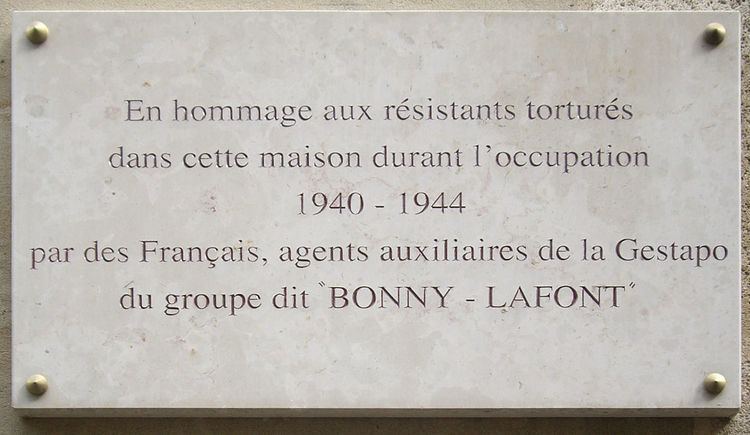 | ||
The Carlingue (or French Gestapo ) were French auxiliaries who worked for the Gestapo, Sicherheitsdienst and Geheime Feldpolizei during the occupation of France in the Second World War. The group, which was based at 93, rue Lauriston in the 16th arrondissement of Paris, was active between 1941 and 1944. It was founded by Pierre Bonny, a corrupt ex-policeman. Later it was jointly led by Henri Lafont and Pierre Loutrel, two professional criminals that had been active in the French underworld before the war. Like the paramilitary Milice, a large cadre of the group were recruited from criminal elements within French society.
Contents
Names
Carlingue in French means the cabin or central body of an aircraft. The unit used this as a euphemistic nickname to indicate it was an organisation, with structure and strength. However externally the group was also known as the Bonny-Lafont gang after Pierre Bonny and Henri Lafont.
Despite the colloquial names, the Reich Main Security Office (RHSA) officially referred to the Carlingue as Active Group Hesse after the SS officer "who'd looked after its foundation". It was also known as the Gestapo française or the Bande de la Rue Lauriston.
History
The unit was formed in 1941 by the RSHA. Its purpose was to conduct counter insurgency operations against the Maquis in occupied France and the Vichy Regime. The Carlingue recruited its members from the same criminal milieu as that of its leaders. Both Henri Lafont and Pierre Loutrel (alias Pierrot le fou (Crazy Pete)) were gangsters in the Parisian underworld before the war. Another member, an ex-cop named Pierre Bonny, had been wanted by the French authorities for misappropriation of funds and selling influence in the Seznec and Stavisky Affairs. Many others in the Carlingue were from the disbanded North African Brigades. The criminal nature of the organisation gave it access to contacts such as informers, corrupt officials, and disreputable business leaders such as Joseph Joanovici. Members were also active in the black market.
According to retired policeman Henri Longuechaud, "one might be scandalised by the numbers of 30,000 to 32,000 sometimes quoted [as members of the Carlingue]. In Paris, when the Germans launched a recruitment drive for 2,000 auxiliary policeman in their service, they received no fewer than 6,000 candidates."
In January and February 1944, the Carlingue, as members of the paramilitary Légion North-Africaine (LNA) under the command of Alexandre Villaplane, wore German uniforms to fight the French Resistance in the area around Tulle, central France.
Following the liberation of France in 1944, members of the Carlingue went into hiding but many were caught, tried and condemned to death but some evaded arrest. One former Carlingue agent, Georges Boucheseiche, who died in Morocco in 1967, was employed by Service de Documentation Extérieure et de Contre-Espionnage, France's post-war external intelligence agency.
In August 2014, the government of Paris ordered the current owners of 93, rue Lauriston to restore the memorial plaque to the former headquarters of the Carlingue.
Notable members
While not a member per se, infamous serial killer Dr Marcel Petiot was closely associated with Carlingue. The house in which he murdered his victims was located in the same street and was sometimes used for Carlingue victims. Conversely, Lafont helped Petiot escape arrest.
